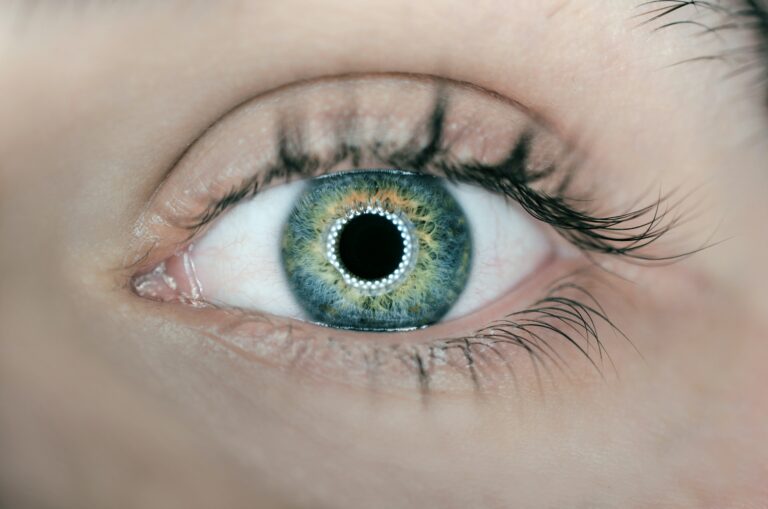If you’ve ever wondered how to get blue eyes, you’re not alone. Many people are curious about changing their eye color to the rare and captivating blue hue. Whether you’re looking for a temporary transformation with colored contact lenses or considering more permanent options like keratopigmentation, there are several ways to achieve that striking blue eye color. In this guide, we explain the most popular methods, their benefits, and what you need to know before making a decision. Keep reading to discover how you can make your dream of blue eyes a reality!
The Science of Eye Color Genetics
Eye color is primarily influenced by genetic factors and the level of melanin in the iris. Melanin, the pigment responsible for the color of your skin, hair, and eyes, exists in two forms that shape eye color: eumelanin (brown and black pigments) and pheomelanin (yellow and red pigments). The unique combination and concentration of these pigments in the iris determine eye color, with blue eyes arising from a significantly low amount of melanin.
Genetic Factors and Eye Color
The genetics of eye color are controlled by several loci, or genetic locations, on chromosomes. A single gene known as OCA2 plays a significant role in the development of blue eyes, although many other genetic factors also contribute.
Blue-eyed individuals typically have a genetic mutation that leads to a reduced amount of brown pigment in the iris. This mutation reduces the melanin levels, causing blue light to scatter in the eye, producing the characteristic blue eye color.
Want to change your eye color?
How to Get Blue Eyes: Methods for Changing Eye Color
Changing the color of your eyes is possible through various methods, whether for aesthetic purposes or personal expression. From non-invasive options like colored contact lenses to permanent procedures, there are several ways to achieve your desired eye color. Explore the options for transforming your color eyes to match your style:
Colored Contact Lenses
One of the most common and accessible ways to change your eye color is through colored contact lenses. These lenses are available in various colors, including blue, and are designed to either enhance or completely change your eye color. Colored contact lenses can be used for both cosmetic and vision correction purposes, making them versatile for different needs.
Types of Colored Lenses
- Decorative Lenses: These lenses are primarily used for changing the appearance of your eyes. Available in shades of blue, green, and even violet, they create a striking transformation but do not improve vision.
- Corrective Lenses: These lenses not only alter eye color but also correct vision issues like nearsightedness or astigmatism. You can find blue contact lenses with a prescription for those who require vision correction.
- Enhancement Lenses: These lenses intensify your natural eye color and are perfect for individuals with lighter-colored eyes, such as those with blue-eyed children.
- Opaque Lenses: For people with darker eye colors, opaque lenses can completely mask the natural eye color and provide a vibrant, bold blue.
While colored contact lenses offer an easy way to achieve blue eyes, it’s important to follow proper vision care practices. Incorrect use of lenses can lead to ocular complications like blurry vision or eye infections. Always purchase lenses from a reputable source and ensure they are FDA-approved for safety.
Colored contact lenses: are they safe?
Keratopigmentation: Dr. Francis Ferrari’s FLAAK Procedure
For those looking for a more permanent solution, keratopigmentation is a great option. This innovative procedure involves implanting colored pigment into the cornea of the eye to change its color. Dr. Francis Ferrari, an expert in the field, offers the FLAAK (Full Layer Anterior Keratopigmentation) technique. The procedure is gaining popularity due to its ability to permanently change the iris color, including turning brown eyes into blue.
How FLAAK Works
The FLAAK procedure involves inserting special pigments into the anterior layer of the cornea, where the pigment epithelium lies. The blue pigment is carefully chosen to mimic the natural shade of blue seen in blue-eyed individuals. This method is considered safe when performed by a skilled professional from a Neoris clinic. The procedure is quick and requires minimal recovery time, making it a popular choice for individuals looking for an eye color variation.
Advantages of Keratopigmentation
- Permanent: Unlike contact lenses, keratopigmentation offers a lasting solution to changing your eye color.
- Customizable: The color can be adjusted to suit your preferences, allowing you to achieve the cooler shades of blue you desire.
- Minimal Recovery: Most patients experience only mild discomfort during the recovery period, and full results are usually visible within a few weeks.
Though keratopigmentation provides an exciting opportunity to change your eye color, it’s essential to consult a professional before proceeding with the procedure.
Before and after images of keratopigmentation
Reasons People Want to Change Their Eye Color
Changing your eye color, especially to a rare color like blue, is a decision that many people make for various reasons. Here are five common motivations for altering eye color:
Aesthetic Preference
For some individuals, the desire to emulate blue-eyed people comes down to pure aesthetics. Eye color can be seen as an important feature in a person’s overall appearance, and many people feel that blue eyes enhance their look.
Fashion and Self-expression
Changing eye color can be an expression of personal style. Some individuals may prefer the boldness of blue eyes, while others might want to experiment with different shades, such as green flecks or lighter hues, to match their skin colors and hair color.
Desire for a Unique Look
The rarest eye color in the world, blue eyes, can help people stand out and achieve a more distinctive or unique appearance. With the advancement of eye color modification methods, blue-eyed individuals are able to express their individuality through their eye color.
Health-Related Reasons
In some cases, people might seek to change their eye color due to health reasons. For instance, some individuals with conditions like ocular albinism or vision problems might turn to cosmetic surgeries as a form of treatment or correction. However, it’s important to be aware of potential ocular complications and consult an expert before pursuing such treatments.
Keratopigmentation Services
At Neoris Clinics, we specialize in keratopigmentation, a cutting-edge procedure that allows you to change your eye color permanently. Using advanced techniques, we implant specially designed pigments into the cornea, offering a safe and customized solution to achieve your desired eye color.
Whether you want to transform your brown eyes to blue or explore other shades, our experienced team ensures the highest standards of care and results.






